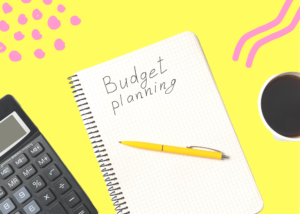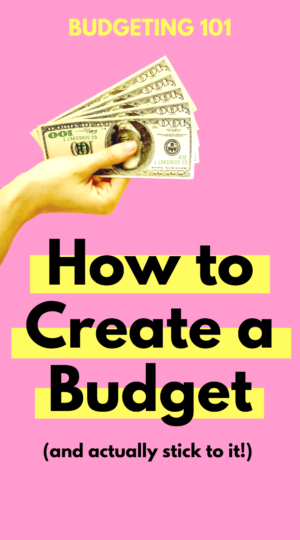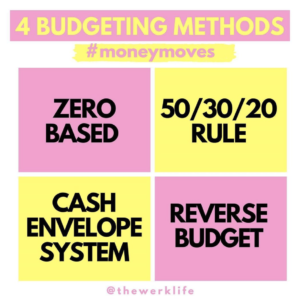
If you’re new to the budgeting scene and you’re wondering how to get started – let’s talk budgeting 101. We’re breaking down to how to budget for beginners by covering some of the most common budgeting methods and systems. Everything from how to create a budget (and actually stick to it!) to keeping yourself accountable, we’ve got you covered. Check out the video below for the full breakdown, or keep reading for more info.
HOW TO BUDGET FOR BEGINNERS
Step 1: Find a system that works for you
The first step when it comes to learning how to budget for beginners, is to find the best budgeting system that works for you. There are tons of ways to budget (and frankly, no right or wrong way), but the important thing is that it’s feasible and sustainable for you. Don’t put too much pressure on yourself when choosing your initial budgeting system. Try it out, see what works, assess what doesn’t, and keep testing out different methods until you’ve found the right one. Let’s review some of the most common methods:
1. 50/30/20 Rule
Coined by Senator Elizabeth Warren, the 50/30/20 rule is where you allocate your budget accordingly:
- 50% of your net income goes towards your “needs” (i.e. rent, groceries, utilities, etc.)
- 30% is allocated to your “wants” (i.e. dinners out, entertainment, travel, etc.)
- 20% is allocated to “savings and debt repayment” (investments, credit card payments, emergency fund deposits, etc.)
2. Cash Envelope System
More of a process versus a system, the cash envelope system is a way to visibly see where your money is going. Here’s how it works:
- start by setting a budget for each category of expense you have coming up for the month (i.e. groceries = $300, entertainment = $200, etc.)
- then, withdraw the amount of cash you expect to use for the upcoming month in total
- divide up the cash, putting the budgeted amount into an envelope for each expense type (i.e. put $300 in an envelope and label it “groceries”, put $200 in an envelope and label it “entertainment”, etc.)
- for the month, cover those expenses solely by pulling out cash from the designated envelope. Once you’re out of cash, you’ve hit your max for that month
3. Zero-Based Budgeting
This budgeting system keeps things pretty simple: allocate every single dollar towards something in your monthly pay, so by the end of the month you’re literally left with $0.
Hold on, though! That doesn’t mean spend every dollar, it means you should pre-determine how much you’re saving as well. Let’s break it down. If you earn $2000 a month and you’re using this system, here’s an example of how it would work:
- $2000 = net income
- $1000 = rent
- $200 = groceries
- $300 = car payments
- $250 = entertainment + other costs
- $250 = savings
In this scenario, you start with $2000, and after all your expenses + pre-determined savings amount ($2000 – 1000 – 200 – 300 – 250 – 50 = $0), you’re left with $0 at the end of the month. This ensures every dollar is allocated towards something and allows you assign a certain amount for savings each month.
4. Reverse Budgeting
A personal favorite, this is a great way to learn how to budget for beginners. In the reverse budgeting system, you start by setting an amount that you’re going to be saving each month, and have the remainder of your budget work around that, versus saving whatever is left over at the end of the month. For example, if you make $2000 a month, instead of lining up all your expenses like rent, groceries, etc. that come with that, you would actually start with how much you hope to save.
So in this case, you may say with a $2000 / month income, you want to save $500 a month. You treat this $500 like a non-negotiable expense, and then work your budget to fit that savings amount. That might mean that you spend less on groceries, cut back on entertainment, or do whatever you need to do in order to hit that $500 savings amount.
Step 2: Record your budget on paper
Then, your next step is to put that budget on paper!
Whether you want to use a budgeting spreadsheet on excel, or use pen to paper by writing it down in a notebook, or use a budgeting pdf template – there are tons of ways to do it! Between the budgeting apps that exist nowadays to all the great resources online, you’ve got options. What’s important here is that you keep track of your budget by creating an actual plan that you can refer back to.
If you struggle with how to record your budget, we’ve pulled together a free 5-Step #MoneyMoves toolkit just for you. We cover everything from budgeting breakdowns to actual pdfs that will help you record your cash flow in and out. To snag your free copy of our #MoneyMoves toolkit, which includes a free budgeting planner pdf – sign up here!
Step 3: Keep yourself accountable
The last and most important step, is to keep yourself accountable. Even if you follow steps one and two, if you’re not keeping yourself accountable, you won’t stick to your budget.
Setting a budget is great, but if you’re not reminding yourself why you should be budgeting in the first place, you’ll lose sight of your end goal. Your end goal may be to save up for a home, pay down debt, or just take the next step towards financial freedom. Whatever your “why” is, you deserve it. You work so hard for your money.
Keep yourself accountable by doing regular check-ins with your budget. At a minimum, make it a habit to review the budget you wrote down in step 2, once a month. If you’re up for it, do it on the weekly. This is where you’ll see your short-term spending add up, allowing you to control the spending early on versus at the end of the month when it’s too late.
[Psst! To snag your free copy of our #MoneyMoves toolkit, which includes a free budgeting planner pdf – sign up here!]How to budget for beginners: taking action
Congrats on taking a very important step in your personal finances – learning how to budget for beginners. You should be proud! Remember: every small step counts, so focus on the short-term wins for the long-term gains!
Want to learn more about how to manage your personal finances? Check out more features from our money section:
- 5 Things You Should Never Spend Money On
- 5 Reasons You Can Never Get Out of Debt
- 11 Financial Habits of the Wealthy
- 5 Money Hacks from Millionaires You Have to Hear
- Investing 101: Why You Should Have Started Investing Yesterday
- Emergency Funds 101: WTF is an Emergency Fund and Why Do I Need One?



